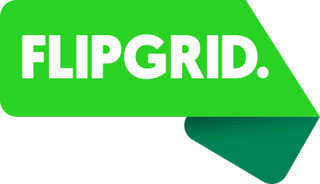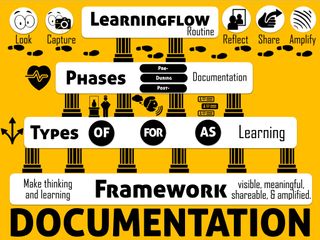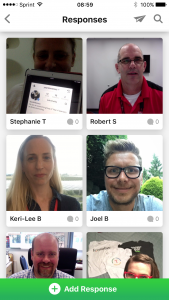I recently learned about this platform, FlipGrid, and am very enthusiastic when I think of the potential it can bring for teachers and learners.

The idea is quite simple.
- An administrator (teacher) creates so called grids of overarching theme or course/classroom section.
- Add individual topic to encourage responses and contributions. Specify length of allowed video response
- Share a specific flipgrid or theme via a link, a text code or a QR code
- Your students or other potential contributors use an app or the web version to record a video response
- Once the video is published, a transcript is automatically generated, and feedback via a reply video and reactions in form of emoticons can be left.
Again, I see tremendous potential for crowdsourcing ideas, perspectives, content, and answers. I can see how the process of reflection and metacognition can be streamlined, embedded and easily shared.
I am in particular excited with the possibilities within the Documenting Learning framework, which Janet Hale and I explore in depth in our upcoming book A Guide to Documenting Learning- Making Thinking and Learning Visible, Meaningful, Shareable and Amplified (to be published in January 2018)
Want to give FlipGrid a try? There is nothing better than to experience before your wheels start spinning how you could apply this in your own situation.

- Follow the link to the topic: How do you make your learning and thinking visible? orUse this code when you open the FlipGrid app (iOS or Android) : f11cb5Scan the following QR code or directly use the embedded topic on this blog
When using the app, you can check out all the other contributions and then “Add Response” by clicking on the green bar, then pushing the red circle to start recording your own response. I set a limit of 30 seconds for response videos. Give it a try… push beyond your comfort zone and record yourself to add your own perspective to other educators from around the world and be part of making-learning-visible strategies and ideas.

Another possibility opening up with FlipGrid, are their Global Grid Connections. Once logged into the admin area, you have access to tons of other educators who are sharing their grids and videos to solicit responses across countries, classrooms, and learners.

In their words:

Global Grid Connections
Global grid connections are great for creating digital pen pals, sharing different cultures, discussing current events, and more. Here are a few tips to get you started.
Create a worldwide collaboration
This one is simple! Set your Grade Level range as wide as possible, choose ‘All’ for your Subject, and add a fun, inspiring goal. Then connect!
Connect with a classroom or two
This is great for digital pen pals! Be specific in your selected Grade Level range and Subject. In your Goal statement, invite others to contact you to discuss your ideas. Once you have your connecting classroom or two, remove your grid from Global Connections.
Build a private connection
If privacy is important to your connection, make sure to Password Protect your grid and activate grid Moderation. In your Goal statement, invite others to contact you directly for the password and additional information.
The potential is there, it now depends on you and your imagination of HOW you could use such a platform to deepen and amplify your and your students’ learning. My wheels are turning how to use FlipGrid FOR your own learning or FOR the learning of others. Are yours?
- Documenting Learning: Learners reflect during specific moments during learning process to capture thinking and evidence of their understanding at current moment in time. Replies to previous videos serve as reflection of learning growth over time.
- Heard about a Time Capsule Activity from Lisa Holtz . Have students record a video at the beginning of the school year, then have them watch and respond to it at the end of the year.
- Reading: Convince someone in 30 seconds to read a book, who does not like to read.
- Book Reviews: Create a Book Review Grid, with individual book titles as topics. Kids share their short book reviews via video for a specific book. Print the QR code out and attach to the physical book.
- Visible Thinking Routines: Use any of Project Zero’s Visible Thinking Routines to help learners make, well, their thinking visible.
- Have students create videos to document their thinking and learning during each step of the KWHLAQ (What do I know? What do I want to know? How will I find out? What have I learning? What Action will I take? What further questions do I have?) routine.
- Create a weekly/daily topic question for a Wonderopolis– style question grid.
- Parent Engagement: Encourage parents to leave replies for their children’s learning contributions. Ask them to contribute their knowledge, perspectives, stories and questions.
- Professional Development: Go beyond learning from colleagues you share an office, a building or students with. Connect with teachers from around the world, about a specific topic you are interested in learning more about or are willing to share your expertise and knowledge.
- Connect your Classroom with other classrooms from around the world. This is especially useful when synchronous video conferencing is not possible due to time zone differences.
- Metacognition is supported by using questions that support the learners awareness and thinking about their thinking, such as “What do you think about what was said?”, “How might you convince us that your way is the best way?”, etc.
- Cross-Pollination: Allow two or more sections of your class to watch, listen, and respond to each others contributions.
Follow #FlipGridFever hashtag on Twitter to connect with other educators and to harvest more ideas.
cross posted at langwitches.org/blog
Silvia Tolisano is a Curriculum21 faculty member, author of the book Digital Storytelling Tools for Educators and founder of the Around the World with 80 Schools project. Read more at http://langwitches.org/blog.

